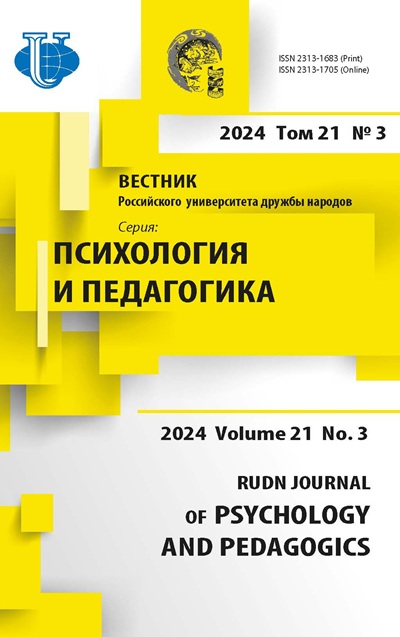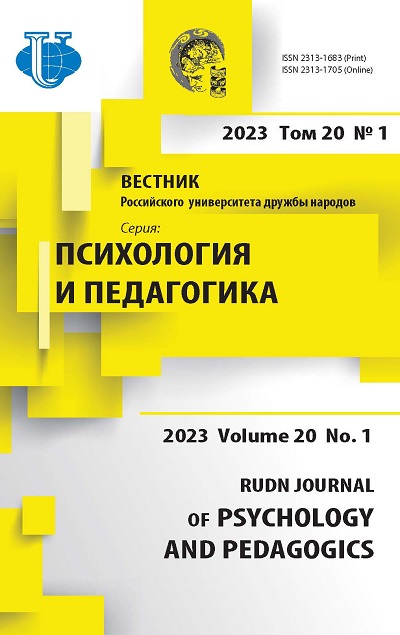Intergroup Contact and Personal and Cultural Stereotypes in Intercultural Relations: A Case of the Stereotype Content in Moscow for Belarusians, Chinese, Uzbeks, and Chechens
- Authors: Grigoryev D.S.1, Komyaginskaya E.S.1
-
Affiliations:
- HSE University
- Issue: Vol 20, No 1 (2023)
- Pages: 41-66
- Section: PERSONALITY AND CONTEMPORARY CHALLENGES
- URL: https://journals.rudn.ru/psychology-pedagogics/article/view/34285
- DOI: https://doi.org/10.22363/2313-1683-2023-20-1-41-66
- EDN: https://elibrary.ru/DOZRIS
Cite item
Full Text
Abstract
The authors use the Stereotype Content Model to consider the relationship between positive and negative intergroup contact and personal and cultural ethnic stereotypes. The introduction poses the theoretical foundations through defining acculturation and adaptation, and also outlining their relationship with stereotypes and intergroup contact in the context of intercultural relations. The empirical part examines intergroup contact and ethnic stereotypes in Moscow about Belarusians, Chinese, Uzbeks, and Chechens with a gender-balanced sample consisted of 316 ethnic Russians aged 16 to 68 (34 years on average). Three competing hypotheses about the correspondence of valence of intergroup contact and stereotypes were considered: (1) constant valence asymmetry; (2) usefulness of stereotype-inconsistent information; (3) epistemic defense. As a result in linear mixed models that (1) personal stereotypes were more positive than cultural ones; (2) however, they were located relative to each other in accordance with the quadrants of cultural stereotypes; (3) intergroup contact was associated with personal stereotypes in the direction according to the valence of the contact; (4) no evidence for interaction between negative contact and cultural stereotypes, whereas the beneficial effect of positive contact was stronger for those ethnic groups with more negative cultural stereotypes. It was concluded that personal experience has only limited scope for improving an already positive attitude, or worsening a negative one. Therefore, only a social policy aimed at changing cultural stereotypes might be efficient.
About the authors
Dmitry Sergeevich Grigoryev
HSE University
Author for correspondence.
Email: dgrigoryev@hse.ru
ORCID iD: 0000-0003-4511-7942
SPIN-code: 1807-9739
PhD, Research Fellow, Center for Sociocultural Research
20 Myasnitskaya St, Moscow, 101000, Russian FederationElizaveta Shamilevna Komyaginskaya
HSE University
Email: eshkomyaginskaya@edu.hse.ru
ORCID iD: 0000-0002-8841-1722
student, master program “Applied Social Psychology”
20 Myasnitskaya St, Moscow, 101000, Russian FederationReferences
- Aberson, C.L. (2015). Positive intergroup contact, negative intergroup contact, and threat as predictors of cognitive and affective dimensions of prejudice. Group Processes & Intergroup Relations, 18(6), 743–760. https://doi.org/10.1177/1368430214556699
- Aberson, C.L., Ferguson, H., & Allen, J. (2021). Contact, threat, and prejudice: A test of intergroup threat theory across three samples and multiple measures of prejudice. Journal of Theoretical Social Psychology, 5(4), 404–422. https://doi.org/10.1002/jts5.107
- Awale, A., Chan, C.S., & Ho, G.T.S. (2019). The influence of perceived warmth and competence on realistic threat and willingness for intergroup contact. European Journal of Social Psychology, 49(5), 857–870. https://doi.org/10.1002/ejsp.2553
- Bai, X., Ramos, M.R., & Fiske, S.T. (2020). As diversity increases, people paradoxically perceive social groups as more similar. Proceedings of the National Academy of Sciences, 117(23), 12741–12749. https://doi.org/10.1073/pnas.2000333117
- Barlow, F.K., Paolini, S., Pedersen, A., Hornsey, M.J., Radke, H.R.M., Harwood, J., Rubin, M., & Sibley, C.G. (2012). The contact caveat: Negative contact predicts increased prejudice more than positive contact predicts reduced prejudice. Personality and Social Psychology Bulletin, 38(12), 1629–1643. https://doi.org/10.1177/0146167212457953
- Batkhina, A. (2020). Values and communication apprehension as antecedents of conflict styles in intercultural conflicts: A study in Germany and Russia. Peace and Conflict: Journal of Peace Psychology, 26(1), 22–34. https://doi.org/10.1037/pac0000429
- Berry, J.W. (2005). Acculturation: Living successfully in two cultures. International Journal of Intercultural Relations, 29(6), 697–712. https://doi.org/10.1016/j.ijintrel.2005.07.013
- Berry, J.W. (2019). Ecocultural psychology (D. Grigoryev, Trans.). Cultural-Historical Psychology, 15(4), 4–16. (In Russ.) https://doi.org/10.17759/chp.2019150401
- Berry, J.W., & Grigoryev, D. (2022). An adaptationist framework to examine intergroup contact. Psychology in Russia: State of the Art, 15(4), 83–100. https://doi.org/10.11621/pir.2022.0406
- Berry, J.W., Lepshokova, Z., MIRIPS Collaboration, & Grigoryev, D. (2022). How shall we all live together? Meta-analytical review of the mutual intercultural relations in plural societies project. Applied Psychology, 71(3), 1014–1041. https://doi.org/10.1111/apps.12332
- Brigham, J.C. (1971). Ethnic stereotypes. Psychological Bulletin, 76(1), 15–38. https://doi.org/10.1037/h0031446
- Crisp, R.J., & Turner, R.N. (2011). Cognitive adaptation to the experience of social and cultural diversity. Psychological Bulletin, 137(2), 242–266. https://doi.org/10.1037/a0021840
- Devine, P.G. (1989). Stereotypes and prejudice: Their automatic and controlled components. Journal of Personality and Social Psychology, 56(1), 5–18. https://doi.org/10.1037/0022-3514.56.1.5
- Dover, T.L., Kaiser, C.R., & Major, B. (2020). Mixed signals: The unintended effects of diversity initiatives. Social Issues and Policy Review, 14(1), 152–181. https://doi.org/10.1111/sipr.12059
- Drobizheva, L.M. (2015). The potential of interethnic consent: Comprehension of the concept and social practice in Moscow. Sotsiologicheskie Issledovaniya, (11), 80–90. (In Russ.)
- Eagly, A.H., & Koenig, A.M. (2021). The vicious cycle linking stereotypes and social roles. Current Directions in Psychological Science, 30(4), 343–350. https://doi.org/10.1177/09637214211013775
- Eagly, A.H., Nater, C., Miller, D.I., Kaufmann, M., & Sczesny, S. (2020). Gender stereotypes have changed: A cross-temporal meta-analysis of U.S. public opinion polls from 1946 to 2018. American Psychologist, 75(3), 301–315. https://doi.org/10.1037/amp0000494
- Filippova, E.I. (2014). Multiculturalism as a policy and as a figure of speech. Vestnik Rossijskoj Natcii, (2), 127–137. (In Russ.)
- Fiske, S.T. (1993). Controlling other people: The impact of power on stereotyping. American Psychologist, 48(6), 621–628. https://doi.org/10.1037/0003-066x.48.6.621
- Fiske, S.T. (2015). Intergroup biases: A focus on stereotype content. Current Opinion in Behavioral Sciences, 3, 45–50. https://doi.org/10.1016/j.cobeha.2015.01.010
- Fiske, S.T. (2017). Prejudices in cultural contexts: Shared stereotypes (gender, age) versus variable stereotypes (race, ethnicity, religion). Perspectives on Psychological Science, 12(5), 791–799. https://doi.org/10.1177/1745691617708204
- Fiske, S.T., Cuddy, A.J.C., Glick, P., & Xu, J. (2002). A model of (often mixed) stereotype content: Competence and warmth respectively follow from perceived status and competition. Journal of Personality and Social Psychology, 82(6), 878–902. https://doi.org/10.1037/0022-3514.82.6.878
- Grigoryev, D. (2022). Ethnic stereotype content beyond intergroup relations within societies: Exploring the North-South hypothesis for competence and warmth. Cross-Cultural Research, 56(4), 345–384. https://doi.org/10.1177/10693971221080618
- Grigoryev, D., Berry, J.W., & Zabrodskaja, A. (2021). Editorial: Stereotypes and intercultural relations: Interdisciplinary integration, new approaches, and new contexts. Frontiers in Psychology, 12, 728048. https://doi.org/10.3389/fpsyg.2021.728048
- Grigoryev, D., Fiske, S.T., & Batkhina, A. (2019). Mapping ethnic stereotypes and their antecedents in Russia: The Stereotype Content Model. Frontiers in Psychology, 10, 1643. https://doi.org/10.3389/fpsyg.2019.01643
- Grigoryev, D.S. (2020a). Contact – Emotion – Prejudice model: The role of colorblindness and perceived ethnic density. Social Psychology and Society, 11(3), 167–184. (In Russ.) https://doi.org/10.17759/sps.2020110311
- Grigoryev, D.S. (2020b). The Stereotype Content Model and ethnic stereotypes in Russia. The Journal of Sociology and Social Anthropology, 23(2), 215–244. (In Russ.) https://doi.org/10.31119/jssa.2020.23.2.9
- Grigoryev, D.S. (2022). Cognitive and motivational foundations underlying acculturation expectations: Applications of ethnic group position model. RUDN Journal of Psychology and Pedagogics, 19(1), 86–109. (In Russ.) https://doi.org/10.22363/2313-1683-2022-19-1-86-109
- Grigoryev, D.S., Batkhina, A.A., & Dubrov, D.I. (2018). Assimilationism, multiculturalism, colorblindness, and polyculturalism in the Russian context. Cultural-Historical Psychology, 14(2), 53–65. (In Russ.) https://doi.org/10.17759/chp.2018140206
- Jussim, L., Crawford, J.T., & Rubinstein, R.S. (2015). Stereotype (in)accuracy in perceptions of groups and individuals. Current Directions in Psychological Science, 24(6), 490–497. https://doi.org/10.1177/0963721415605257
- Kosmarskaya, N., & Savin, I. (2021). Perception of migrants by Muscovites through the lens of the contact hypothesis. Etnograficheskoe Obozrenie, (1), 94–111. (In Russ.) https://doi.org/10.31857/S086954150013600-0
- Kotzur, P.F., & Wagner, U. (2021). The dynamic relationship between contact opportunities, positive and negative intergroup contact, and prejudice: A longitudinal investigation. Journal of Personality and Social Psychology, 120(2), 418–442. https://doi.org/10.1037/pspi0000258
- Kotzur, P.F., Schäfer, S.J., & Wagner, U. (2019). Meeting a nice asylum seeker: Intergroup contact changes stereotype content perceptions and associated emotional prejudices, and encourages solidarity‐based collective action intentions. British Journal of Social Psychology, 58(3), 668–690. https://doi.org/10.1111/bjso.12304
- Kotzur, P.F., Veit, S., Namyslo, A., Holthausen, M.-A., Wagner, U., & Yemane, R. (2020). ‘Society thinks they are cold and/or incompetent, but I do not’: Stereotype content ratings depend on instructions and the social group's location in the stereotype content space. British Journal of Social Psychology, 59(4), 1018–1042. https://doi.org/10.1111/bjso.12375
- Kozlova, M., & Ryabichenko, T. (2021). Ideologies of intergroup relations in pedagogical discourse: Representation of cultures and intercultural interaction in the educational books for migrant children. Journal of Intercultural Communication Research, 50(6), 541–555. https://doi.org/10.1080/17475759.2021.1910065
- Kuznetsov, I.M. (2017). The balance of interethnic attitudes as an indicator of state of interethnic relations. Universe of Russia, 26(1), 58–80. (In Russ.)
- Lebedeva, N., Tatarko, A., & Berry, J.W. (2016). Intercultural relations among migrants from Caucasus and Russians in Moscow. International Journal of Intercultural Relations, 52, 27–38. https://doi.org/10.1016/j.ijintrel.2016.03.001
- Montreuil, A., & Bourhis, R.Y. (2001). Majority acculturation orientations toward “valued” and “devalued” immigrants. Journal of Cross-Cultural Psychology, 32(6), 698–719. https://doi.org/10.1177/0022022101032006004
- Mukomel', V.I. (2021). Migration situation and migrants in the perception of Russians. Vestnik Rossijskoj Natcii, (1–2), 53–68. (In Russ.)
- Neuberg, S.L., Williams, K.E.G., Sng, O., Pick, C.M., Neel, R., Krems, J.A., & Pirlott, A.G. (2020). Toward capturing the functional and nuanced nature of social stereotypes: An affordance management approach. Advances in Experimental Social Psychology, 62, 245–304. https://doi.org/10.1016/bs.aesp.2020.04.004
- Novikov, A.L., & Novikova, I.A. (2019). Ethnic stereotypes in intercultural communication: Psychological and semantic aspects. RUDN Journal of Language Studies, Semiotics and Semantics, 10(4), 977–989. (In Russ.) https://doi.org/10.22363/2313-2299-2019-10-4-977-989
- Paolini, S., & McIntyre, K. (2019). Bad is stronger than good for stigmatized, but not admired outgroups: Meta-analytical tests of intergroup valence asymmetry in individual-to-group generalization experiments. Personality and Social Psychology Review, 23(1), 3–47. https://doi.org/10.1177/1088868317753504
- Pettigrew, T.F., & Tropp, L.R. (2006). A meta-analytic test of intergroup contact theory. Journal of Personality and Social Psychology, 90(5), 751–783. https://doi.org/10.1037/0022-3514.90.5.751
- Popper, M., & Kollárová, V. (2018). Testing SCM questionnaire instructions using cognitive interviews. Human Affairs, 28(3), 297–311. https://doi.org/10.1515/humaff-2018-0024
- Reimer, N.K., Becker, J.C., Benz, A., Christ, O., Dhont, K., Klocke, U., Neji, S., Rychlowska, M., Schmid, K., & Hewstone, M. (2017). Intergroup contact and social change. Personality and Social Psychology Bulletin, 43(1), 121–136. https://doi.org/10.1177/0146167216676478
- Riek, B.M., Mania, E.W., & Gaertner, S.L. (2006). Intergroup threat and outgroup attitudes: A meta-analytic review. Personality and Social Psychology Review, 10(4), 336–353. https://doi.org/10.1207/s15327957pspr1004_4
- Sam, D.L., & Berry, J.W. (2010). Acculturation: When individuals and groups of different cultural backgrounds meet. Perspectives on Psychological Science, 5(4), 472–481. https://doi.org/10.1177/1745691610373075
- Shamionov, R.M. (2018). Formation of discriminatory personal attitudes in the process of socialization. Izvestiya of Saratov University. Educational Acmeology. Developmental Psychology, 7(2), 129–135. (In Russ.) https://doi.org/10.18500/2304-9790-2018-7-2-129-135
- Soldatova, G.U. (1993). Research on dynamics of ethnic stereotypes. In P.N. Shikhirev (Ed.), Socio-Psychological Studies of Interethnic Relations. Moscow: Institute of Psychology Russian Academy of Sciences. (In Russ.)
- Stanciu, A., Vauclair, C.-M., & Rodda, N. (2019). Evidence for stereotype accommodation as an expression of immigrants’ socio-cognitive adaptation. International Journal of Intercultural Relations, 72, 76–86. https://doi.org/10.1016/j.ijintrel.2019.07.003
- Stepanov, V.V., & Tishkov, V.A. (Eds.). (2014). Social factors of ethnic intolerance (results of an interdisciplinary study). Moscow: Institute of Ethnology and Anthropology Russian Academy of Science. (In Russ.)
- Varshaver, E.A. (2015). Contact theory: Review. Monitoring of Public Opinion: Economic and Social Changes, (5), 183–214. (In Russ.) https://doi.org/10.14515/monitoring.2015.5.13
- Visintin, E.P., Voci, A., Pagotto, L., & Hewstone, M. (2017). Direct, extended, and mass-mediated contact with immigrants in Italy: Their associations with emotions, prejudice, and humanity perceptions. Journal of Applied Social Psychology, 47(4), 175–194. https://doi.org/10.1111/jasp.12423
- Voronina, N.S., & Fadeev, P.V. (2020). Who is set against migrants in Russia? Analyzing certain socio-demographic characteristics. Bulletin of the Institute of Sociology, 11(4), 99–125. (In Russ.) https://doi.org/10.19181/vis.2020.11.4.681
- Walsh, S.D., & Tartakovsky, E. (2021). Personal value preferences, threat-benefit appraisal of immigrants and levels of social contact: Looking through the lens of the Stereotype Content Model. Frontiers in Psychology, 12, 609219. https://doi.org/10.3389/fpsyg.2021.609219
- Zingora, T., Vezzali, L., & Graf, S. (2021). Stereotypes in the face of reality: Intergroup contact inconsistent with group stereotypes changes attitudes more than stereotype-consistent contact. Group Processes & Intergroup Relations, 24(8), 1284–1305. https://doi.org/10.1177/1368430220946816

















